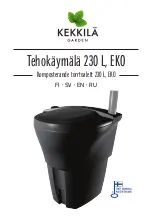
2
INSTALLATION
The 37075-Series Designer Styled Toilet includes the
Quiet-Flush Toilet pumping system and is supplied with
a solenoid valve/siphon breaker to control the supply of
rinse water to the toilet bowl. The siphon breaker pre-
vents the potential for contamination of the water so the
toilet can be flushed with potable water. The toilet also
includes a multi-function flush control which should be
installed in a bulkhead location that is convenient to the
toilet and allows access for wiring to run from the power
source and to both the toilet discharge pump and sole-
noid valve/siphon breaker. Because all plumbing and
wiring connections at the toilet are made internally with-
in the china bowl, all plumbing and wiring must be com-
pleted and extended to the toilet location prior to final
installation of the toilet.
Install the toilet seat and lid assembly on the china bowl
with the fasteners provided and position the toilet in its
desired location. When locating the toilet, ensure there is
adequate clearance above the bowl so the seat and lid
assembly can rotate to its fully open position and remain
open on its own. Once the exact position has been
determined, mark the location of the two toilet mount-
ing holes on the toilet mounting surface and move the
toilet, temporarily, out of the way. When securing the
toilet to a plywood underlayment below a layer of fiber-
glass, to avoid cracking the fiberglass, drill a 5/16
"
(8
mm) hole through just the fiberglass layer to provide
clearance for the screw threads and shank. Drill a 3/16
"
(5 mm) pilot hole to accept the threaded portion of the
toilet hold-down screw set provided. It is generally best
to wait until the toilet is ready to be installed for the final
time before screwing the hold-down screw into the
mounting surface.
To make the water connection, shut off the water system
pump and open one of the systems faucets or fixtures to
drain the pressure from the system. Select an appropri-
ate tee type fitting that can be installed in the existing
pressurized water system and will provide a 1/2
"
(13
mm) hose barb to feed water to the toilet. Install the tee
fitting at a location on the pressurized water system that
provides convenient connection to the toilet’s solenoid
valve/siphon breaker assembly. If the toilet is being con-
nected to the vessel’s fresh water system and the vessel
may be connected to an unregulated city water supply, it
is recommended that a valve be installed in the toilet
water supply line ahead of the solenoid valve/siphon
breaker to regulate the flow rate of incoming pressurized
city water.
The solenoid valve/siphon breaker should be positioned
a minimum of six inches above the hose connection at
the back of the toilet bowl and located as close to the toi-
let as possible. It must be installed in a vertical position
with the hose barb connections pointing down. The sole-
noid valve/siphon breaker bracket should be secured to
a solid mounting surface with four screws. If the valve
assembly is attached to a wood surface, 3/8
"
(10 mm)
long screws are generally adequate to support the
weight of the valve assembly. If desired, the valve
assembly may be installed inside a cabinet or locker to
conceal it from view of the vessel’s occupants. Run a
length of 3/4
"
hose from the barb at the back of the bowl
to the siphon breaker discharge port.
The solenoid valve inlet hose barb is then connected
with 1/2
"
(13 mm) reinforced vinyl hose suitable for
pressurized water to the tee fitting installed in the water
system line. All pressurized water system connections
should be secured with stainless steel band type hose
clamps. The hose connecting the siphon breaker to the
bowl should be secured with a band clamp at the siphon
breaker to prevent it from being accidentally dislodged
but generally does not need a hose clamp to secure it to
the bowl spud fitting unless desired for added security.
The toilet discharge port is sized for 1
"
(25 mm) hose.
The discharge hose should be a quality grade reinforced
hose suitable for waste applications. Route the discharge
hose to the holding tank in the most direct way with as
few bends as possible. To retain some water in the bowl,
it is best to loop the discharge hose up about 8-10 inches
(15-20 cm) as close to the toilet as practical then on the
holding tank. Providing adequate length of hose to
include such a loop also will provide the ability to move
the toilet out away from the bulkhead it butts against to
complete the hose connections. It is best to avoid any
dips or low spots in the discharge plumbing that can act
as water traps and collect waste as it runs on to the hold-
ing tank. If this occurs, waste can solidify and cause a
discharge blockage.
Waterline
Vented Loop
Heeled Waterline


























